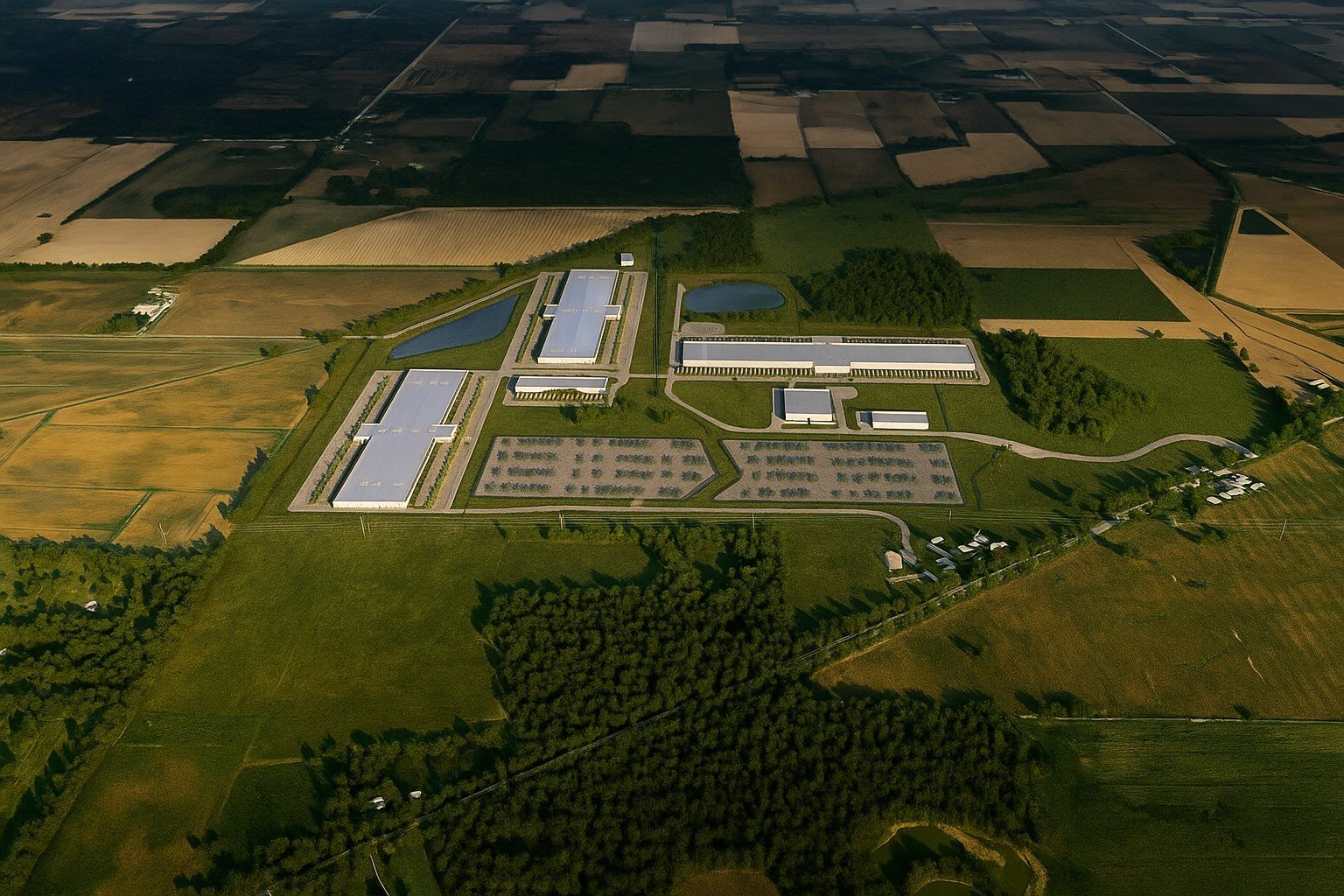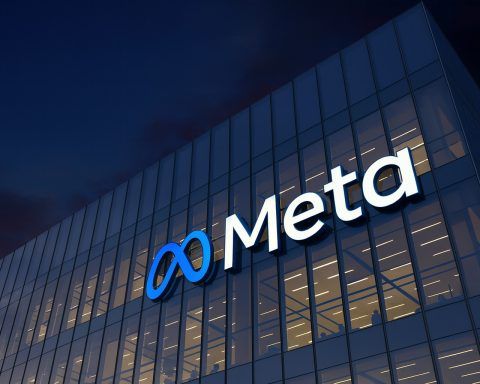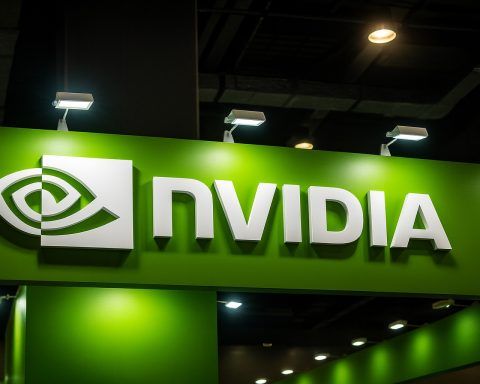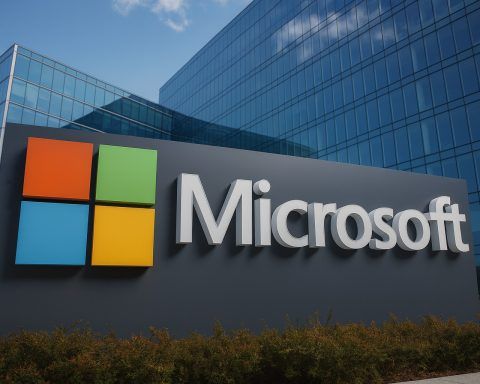- Gigawatt-Scale Campus: OpenAI, Oracle and developer Related Digital will build a 1 gigawatt (“Stargate”) AI data center in Saline Township (Washtenaw County) on former farmland, making it Michigan’s first hyperscale data center [1] [2]. The project is estimated at ~$7+ billion (Wall Street Journal) and praised by Gov. Whitmer as “the largest economic project in Michigan history” [3] [4].
- Jobs and Investment: Construction (starting early 2026) is expected to create ~2,500 union trades jobs and over 450 permanent on-site jobs [5] [6]. State officials note Related Digital will also invest $14 million in local fire departments, community funds and farmland conservation as part of the agreement [7]. Whitmer said the deal “sends a simple message – you can build [the future] in Michigan” [8].
- Power & Water Solutions: DTE Energy will supply roughly 1.4 GW of power for the campus (about 25% more than its current Saline load) using upgraded grid capacity and a new $2B battery storage system paid for by the developers [9] [10]. The facility will use closed-loop cooling, meaning no new water will be drawn from the Great Lakes, and will preserve ~700 acres of the 575-acre site for wetlands, farmland and forest [11] [12]. Officials emphasize it won’t require new power plants or extra Great Lakes water [13] [14].
- State Support: Michigan lawmakers recently approved new tax incentives for large data centers (e.g. sales/use tax exemption) to lure big tech [15] [16]. Whitmer cited Michigan’s strong tech workforce and bipartisan bills cutting AI infrastructure costs as reasons the project chose the state [17]. Analysts say this is part of Michigan’s push to become an AI hub alongside its auto and battery industries.
- Market Reaction: Oracle’s stock (NYSE: ORCL) has surged about +70% year-to-date 2025 on AI/cloud optimism, trading near ~$264 on Oct. 31 [18]. NVIDIA’s share price briefly powered Nvidia to a historic $4.4–$4.5 trillion market cap in October as its AI hardware sales boomed [19]. AMD also jumped (≈+34% on Oct. 6) after striking a multi‐GW AI chip deal with OpenAI [20]. Wall Street analysts are generally bullish: many now rate Oracle as a “buy” with 12–18 month targets well above current levels (median ~$324) [21] and see Nvidia continuing strong growth (average NVDA targets ~$210–$220, some as high as $320) [22]. However, some experts warn of frothy valuations and an “AI bubble” as Big Tech ramps up spending [23] [24].
Mega Deal in Michigan: Project and Partners
OpenAI’s “Stargate” initiative – an effort to build massive new data centers nationwide – has selected Michigan for a key phase. On Oct. 30, OpenAI confirmed that with Oracle and Related Digital it will develop a gigawatt-scale AI compute campus on ~575 acres of farmland in Saline Township, near Ann Arbor [25] [26]. The complex will include three single-story server buildings (each ~550,000 sq ft) occupying ~250 acres, plus supporting infrastructure [27] [28]. Construction is slated to begin early 2026, subject to local approvals.
The total investment is enormous – reported at more than $7 billion [29] – making it roughly on par with past deals like GM’s $7B Michigan auto plants. Gov. Gretchen Whitmer hailed it as “the largest economic project in Michigan history” [30] [31]. Whitmer said the deal brings “good-paying local jobs” and signals that cutting-edge companies can succeed in Michigan [32]. Peter Hoeschele, OpenAI’s VP of industrial compute, echoed the theme: “This project will help ensure Michigan is a key part of building the AI infrastructure that will power the next generation of American innovation” [33].
Related Digital – a subsidiary of developer Related Cos. (founded by billionaire Stephen Ross) – will lead construction. CEO Brent Behrman noted the firm’s data-center track record and “looks forward to beginning construction in early 2026” [34]. (Related’s parent company is a major donor to the University of Michigan, but Ross himself has no direct role in this venture [35].) OpenAI says the Saline site is one of at least seven U.S. hyperscale facilities in its $500 billion AI buildout plan announced in January [36] [37]. Early this week, OpenAI also announced a separate $15B data-center deal (with Oracle and Vantage) in Milwaukee [38], underscoring its multi-state expansion.
Community, Environment and Local Issues
Locals had mixed reactions. After Saline Township initially voted down rezoning for the project, Related Digital sued and a settlement was reached that lifted the rezoning ban. The company agreed to community benefits – including the $14M contributions to local services and farmland trust required by township officials [39]. Township leaders say once built, the facility will blend into the landscape and “you won’t even know what’s there” [40]. Proponents stress the jobs (more than 2,500 construction jobs and 450 permanent tech jobs county-wide [41] [42]) and new tax revenue from the development.
But some farmers and environmentalists are wary. Michigan’s rural areas are coveted for cheap land and power, and opponents fear a slew of power-hungry centers could strain local resources. Residents in nearby Livingston County recently called for a moratorium on new data center rezoning amid concerns over Michigan’s clean-energy goals [43]. Energy expert Regina Kudla (Ypsilanti area) questioned how many data centers are “needed” and whether their water/energy use might outpace supplies [44].
The companies emphasize “closed-loop” cooling to limit water use. OpenAI and officials stress the Saline center will recycle its cooling water on-site, using no additional Great Lakes water [45] [46]. They also plan to preserve over 700 acres (of the 575-acre site plus surroundings) as farms, wetlands and woods [47] [48]. Still, long-term energy demand is a concern: Michigan utilities say their climate plans must now incorporate big new loads.
Utility & Infrastructure Demands
Both DTE Energy and Consumers Energy are scrambling to meet soaring power demand from data centers. Hours before the OpenAI announcement, DTE reported it had struck a deal to supply 1.4 GW for an unnamed Michigan data center [49] – later confirmed as the Saline project. DTE CEO Joi Harris called the deal “an exciting milestone” that could actually lower costs for other customers by spreading grid maintenance expenses over more load [50]. DTE is expanding its long-range plan accordingly: on Oct. 30 it raised its five-year capex budget 22% to $36.5 billion, largely to strengthen the grid and support data-center customers [51]. The Saline deal is DTE’s first at this scale, and executives say they’re in talks for 6–7 more GW with other hyperscalers [52].
Consumers Energy (the state’s other big utility) reports similar momentum. Executives announced pending agreements to provide roughly 2 GW in total for three data centers [53] – double what they had predicted months ago. (Microsoft alone has bought sites in Consumers’ territory.) Both utilities plan to meet the surge with more batteries and, ultimately, new natural-gas generation: DTE has announced a forthcoming gas plant to replace retiring coal, and Consumers says it will file plans for new gas and battery capacity [54] [55]. These fossil-fuel boosts are controversial: Michigan law counts gas+carbon-capture as “clean,” but environmental advocates (Michigan Environmental Council’s Charlotte Jameson) warn that utilities are undermining the state’s 2040 carbon-free mandate [56]. They urge binding clean-energy commitments in data-center contracts.
Broader AI Data-Center Boom
Michigan’s windfall is part of a nationwide AI infrastructure land grab. Governor Whitmer noted the Saline campus follows a series of megadeals, including Vantage Data Centers’ Milwaukee facility with OpenAI and Oracle (announced Oct. 28) [57]. Across the U.S., Google, Microsoft and other tech giants already run hyperscale centers; the OpenAI-Oracles hubs represent a new wave. State legislators took notice – in 2024 Michigan created new tax breaks (like an equipment sales tax exemption) to compete for these projects [58] [59].
Locally, other proposals are advancing amid mixed local sentiment. In Howell Township (Livingston County), a private developer’s plan for a 500 MW center has sparked public hearings and opposition. Lawmakers on a recent Michigan Public Service Commission panel heard crowds protesting the rapid data-center buildout and its impact on the carbon-free goal [60]. Still, economic-development officials see opportunity: Ann Arbor Spark COO Phil Santer told Bridge Michigan the Saline project adds to the region’s tech assets and could shape a broader AI strategy for the state [61].
At the national level, data-center expansion is colliding with supply issues. New federal export limits on high-end chips have curbed NVIDIA sales to China and prompted rivals (AMD, Broadcom) to sign huge AI supply deals [62]. For example, AMD agreed to provide ~6 GW of GPUs to OpenAI starting 2026 (with an option to buy 10% of AMD) [63], sending AMD’s stock up ~34% on Oct. 6 [64]. Microsoft, meanwhile, is building dozens of new server farms for Azure.
Tech Stock Reaction & Outlook
Investors have rewarded companies tied to AI power and infrastructure. Oracle (ORCL) – OpenAI’s cloud partner on this project – has been a standout. Oracle shares traded near ~$257 on Oct. 30 [65], roughly 70% above their level a year ago, amid frenzy over multi-$100B AI contracts. Wall Street analysts have largely turned bullish: Jefferies, Barclays and others raised ORCL ratings to “Buy” with 12–18 month price targets often in the $360–$400 range [66]. Analyst consensus (MarketBeat) puts the 12-month target at ~$324 [67], well above current price. CFO Safra Catz even described the quarter’s momentum as “astonishing,” and Oracle is planning to double down – raising its 5-year capex on data-center builds to ~$35 billion [68].
Still, some caution remains. Oracle’s valuation is now around 45–60× forward earnings, a premium to peers, and CNBC’s Jim Cramer warned it may be “the only [tech] one I’m worried about” given its heavy bet on one big OpenAI deal [69] [70]. A Redburn analyst also called the reported $300B OpenAI-Oracle contract “very risky” if it fails to materialize [71].
NVIDIA (NVDA) continues to dominate the conversation. Its shares rocketed through October (driving its market cap past $4.4 trillion, briefly making it the world’s most valuable company [72]). October’s results were stellar – $46.7B revenue in Q2 FY2026 (a 56% YoY jump, mostly AI chips) [73] – and management is guiding similar gains. Analysts overwhelmingly rate NVDA a “Buy” (38 of 47) with average targets ~$210–$220 [74], and several see much higher potential (HSBC’s target is $320, implying ~80% upside [75]). Still, some warn that NVIDIA’s ~50× earnings multiple leaves little margin for error [76].
Microsoft (MSFT) shares dipped on Oct. 29 after an earnings report showed record cloud growth but also a $35B Q1 capex – higher than previously guided [77] [78]. In post-market trading MSFT fell ~4% on investor worry that spending to satiate AI demand is outpacing profits [79]. Microsoft’s Azure grew 40% in Q1, but CFO Amy Hood warned that capacity constraints will likely persist. The company projects continued high growth but needs to balance costly data-center buildout with returns [80] [81].
Outlook: The Michigan deal underscores the AI arms race: as OpenAI commits $500B to infrastructure, companies that own or power that infrastructure stand to gain. Oracle’s recent “astonishing” results and stock surge exemplify the hype [82]. According to TS2 analysts, Oracle expects OCI (cloud) revenue to climb from ~$18B to over $100B in a few years [83] – a testament to bullish management forecasts. But the same analysts note that if the AI boom slows, stocks are priced for perfection. For now, experts say investors should watch for execution. As one technologist put it, these new data centers – and the chips that power them – are “the future of technology,” and so far Wall Street is betting big on that future [84] [85].
Sources: Recent news from Reuters, AP/Bridge Michigan, CBS Detroit, Axios and TS2.tech [86] [87] [88] [89] [90] [91]. These include official statements, utility filings and market analyses up to Nov. 1, 2025.
References
1. apnews.com, 2. www.axios.com, 3. apnews.com, 4. www.cbsnews.com, 5. apnews.com, 6. www.cbsnews.com, 7. www.cbsnews.com, 8. www.cbsnews.com, 9. apnews.com, 10. apnews.com, 11. www.cbsnews.com, 12. www.axios.com, 13. www.cbsnews.com, 14. www.cbsnews.com, 15. apnews.com, 16. www.cbsnews.com, 17. www.cbsnews.com, 18. ts2.tech, 19. ts2.tech, 20. ts2.tech, 21. ts2.tech, 22. ts2.tech, 23. www.reuters.com, 24. ts2.tech, 25. apnews.com, 26. www.axios.com, 27. apnews.com, 28. www.axios.com, 29. apnews.com, 30. apnews.com, 31. www.cbsnews.com, 32. www.cbsnews.com, 33. www.reuters.com, 34. www.cbsnews.com, 35. www.axios.com, 36. www.cbsnews.com, 37. www.axios.com, 38. apnews.com, 39. www.cbsnews.com, 40. apnews.com, 41. apnews.com, 42. www.cbsnews.com, 43. www.cbsnews.com, 44. apnews.com, 45. www.cbsnews.com, 46. www.axios.com, 47. www.cbsnews.com, 48. www.cbsnews.com, 49. apnews.com, 50. apnews.com, 51. www.reuters.com, 52. www.reuters.com, 53. apnews.com, 54. apnews.com, 55. apnews.com, 56. apnews.com, 57. apnews.com, 58. apnews.com, 59. www.cbsnews.com, 60. www.cbsnews.com, 61. apnews.com, 62. ts2.tech, 63. ts2.tech, 64. ts2.tech, 65. ts2.tech, 66. ts2.tech, 67. ts2.tech, 68. ts2.tech, 69. ts2.tech, 70. ts2.tech, 71. ts2.tech, 72. ts2.tech, 73. ts2.tech, 74. ts2.tech, 75. ts2.tech, 76. ts2.tech, 77. www.reuters.com, 78. www.reuters.com, 79. www.reuters.com, 80. www.reuters.com, 81. www.reuters.com, 82. ts2.tech, 83. ts2.tech, 84. ts2.tech, 85. ts2.tech, 86. www.reuters.com, 87. apnews.com, 88. apnews.com, 89. www.cbsnews.com, 90. ts2.tech, 91. ts2.tech






